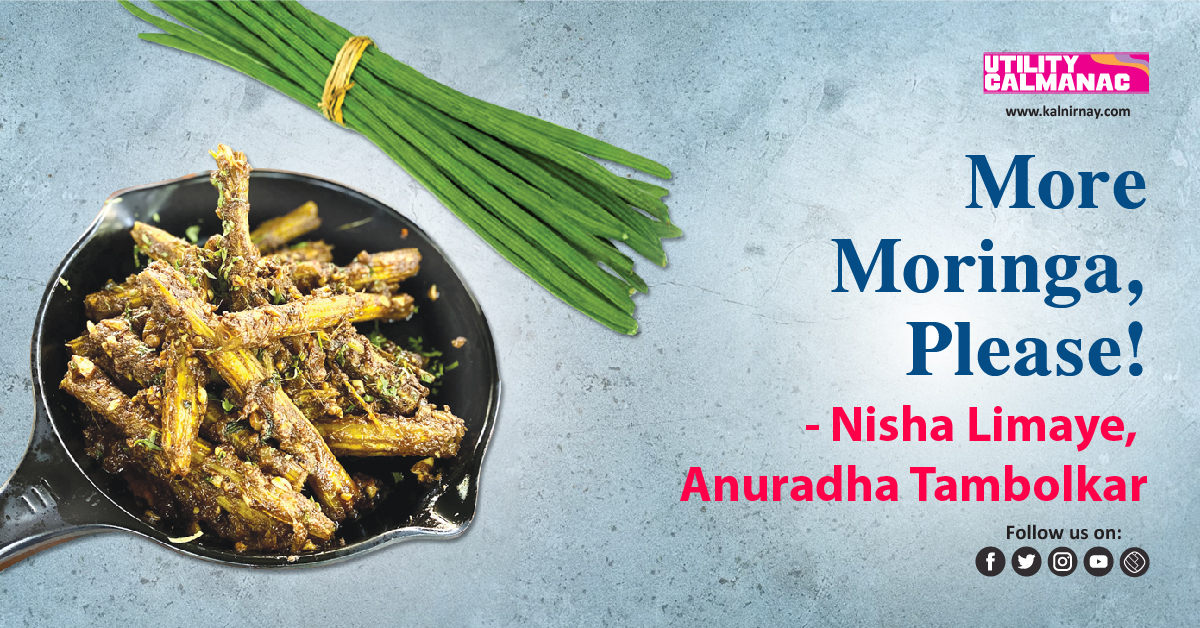More Moringa, Please!
The moringa plant is a source of diverse ingredients in Indian food.
If the ingredients that we eat were to be listed according to their medicinal benefits, all parts of the Moringa tree would be right at the top because of their innumerable health benefits. No part of the tree goes to waste – the roots, trunk, branches, and even the flowers of this plant are incredibly useful. Ayurveda, specifically, gives the drumstick tree immense importance. This ancient medicine system claims that the plant is beneficial for around 300 minor and major health ailments.
The Moringa tree is evergreen and can be divided into wild and standard varieties. It is found commonly in rural areas and has a great demand internationally.
In India, the drumstick seed pod enhances the flavour of dishes like Sambar, Amti and Kadhi. One can also make a curry using its flowers. A drumstick soup is nourishing and delicious and is usually given to children when they are 6 months old. Like the drumstick pods, the plant’s tender leaves are also widely eaten. We call them tisra in Marathi and use them in a curry made using moong dal. Even a thalipeeth or paratha can feature the delicious moringa leaves.
A ripe drumstick can be peeled and boiled in salt water and eaten as is. Similarly, the leaves and roots can be used to make bhaji, chutneys, and other dishes. Hence, it is said that the moringa tree must grow in every house.
I have fond memories of dishes made with drumsticks at my parents’ home. Guests would usually be served pithla (a curry made from gram flour) consisting of drumsticks. Years ago, my grandmother cooked Amti (a Maharashtrian dal preparation) with drumsticks and served this to the famous actor Prithviraj Kapoor, a guest at our home in Shrirampur. At that time, it was my grandfather who showed him how to eat the drumsticks — how they had to be sucked and cleaned before discarding. He liked it so much that he repeatedly asked for more even though he was feeling awkward doing so! Eventually, he asked my grandmother to bring the vessel containing the Amti and ate it to his heart’s content.
The Medicinal Benefits
Drumsticks have Vitamins A, B and C, and are naturally fortified with iron, calcium, potassium, sulphur and protein, apart from all the fibre they contain. They are beneficial for people suffering from skin diseases, cancer, heart trouble and ailments of the ears and eyes.
Drumsticks help overcome the wear and tear of the bones and strengthen them. They are also beneficial for those suffering from intestinal problems, constipation, arthritis, eye problems, kidney stones, low haemoglobin, digestive problems, diabetes, cough and cold, asthma and hair fall. In rural areas, moringa seeds are used to purify water. Pregnant women and lactating women are advised to eat moringa seeds for easy delivery and to improve lactation.
Regular consumption of the juice of moringa leaves can control hypertension. Mixing this juice with honey and applying it on the face can clear the skin, and consuming the mixture can help treat loose motions and intestinal worms. The powdered extract of the roots is applied to wounds.
The green leaves of the moringa can be dried on a cloth at home and later ground in a mixer. This powder can be stored in an airtight container and consumed every morning by cancer patients and those with heart trouble and hypertension. It also helps reduce weight and tackle stomach ulcers. The hardened seeds of the drumstick pods also have medicinal use. Considering these benefits, it is rightly referred to as a ‘miracle tree’. A word of caution: while the drumstick tree has many benefits, the consumption of its many parts is prevented in summer as it is considered a ‘heaty’ ingredient.
Recipes
1. Drumstick Leaves Curry
Wash and cut tender drumstick leaves. Add moong dal, green chillies and garlic paste, and some besan or bhajani flour. Add a little water, cook on a low flame and serve hot.
2. Drumstick Leaves Dumpling
Mix besan or bhajani flour with drumstick leaves and ginger-garlic paste. Add some oil, water and soda, followed by four spoons of semolina or rawa. Mix and shape into dumplings. Steam the balls and toss them in a tempering similar to that for dhoklas. You can also make a curry.
3. Drumstick Soup
Cut drumsticks into small pieces and cook them on a low flame. Then add some drumstick leaves, and when the water reduces to half, extract the pulp and discard the fibrous bits. Add salt, red chilli powder, and butter. Mix it all and drink it as a clear soup.
4. Drumstick Fry
Peel some drumsticks and cut them into finger-long pieces, cook them for one whistle in a cooker on a medium flame or boil them in water for 10 minutes. Now, heat oil in a pan, add ample quantities of coriander, tomato, and ginger-garlic paste and fry till the mixture acquires a chocolate-like colour.
Add Goda masala and turmeric and mix it again before adding the cooked drumsticks. Then, put mace powder, red chilli powder, and haldi; mix well. Cover and cook on a low flame for five minutes. Mix and serve with hot bhakris.
To read more English blogs, please visit our blog section.
» Nisha Limaye, Anuradha Tambolkar
The authors are food entrepreneurs and researchers.

